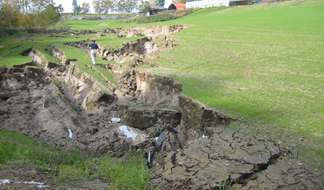 Just as a flash
of lightning across the sky warns of coming thunder, the first flash of an earthquake
can hint at the seismic waves that will follow. Instead of indicating the distance
of a storm, however, researchers suggest that the first few seconds of an earthquake
have the potential to reveal the final size that an earthquake will grow to
be — with implications for how earthquakes physically unfold.
Just as a flash
of lightning across the sky warns of coming thunder, the first flash of an earthquake
can hint at the seismic waves that will follow. Instead of indicating the distance
of a storm, however, researchers suggest that the first few seconds of an earthquake
have the potential to reveal the final size that an earthquake will grow to
be — with implications for how earthquakes physically unfold. Collapsed embankments lie near Toyokoro, Japan, from the 2003 Tokachi-oki earthquake, a magnitude-8.3 event that lasted 40 seconds. Researchers used this earthquake in a model, to help determine whether the ultimate size of a large earthquake can be calculated within the first couple of seconds of shaking. Image courtesy of Scott Ashford.
A model published in 2003, called ElarmS, introduced a potential early warning system for Southern California, providing warning tens of seconds in advance of the first large damaging waves to arrive in an area from an earthquake. Building on that work, conducted by Richard Allen of the University of California in Berkeley and Hiroo Kanamori of Caltech in Pasadena, Calif., Erik Olson of the University of Wisconsin in Madison teamed with Allen to test the results. Using a global catalog that included well-observed, large-magnitude earthquakes from around the world, they hoped to show that the ElarmS concept could work elsewhere, and that it could be used to predict the final magnitude of an earthquake.
Using more than 1,800 recordings of 71 earthquakes, 24 of which were greater than magnitude 6, the researchers documented a trend showing that within the first 2 to 3 seconds of the start of its rupture along a fault, an earthquake gives off an initial peak wave of energy that is directly related to the final size of the complete event to come. (Earthquakes smaller than magnitude 4 take less than 4 seconds to complete rupturing a fault.) But the scaling relationship between that first jolt and the final size of an earthquake remains approximate.
During a large earthquake, the shaking lasts longer than the 10 seconds or more that a fault may take to break. “Anything that will allow us to shave off a minute, 2 minutes, to get the location and size of an earthquake will be useful,” says William Leith, coordinator of the Advanced National Seismic System for the Earthquake Hazards Program of the U.S. Geological Survey, which has helped fund the research. An early warning and a final magnitude prediction of a large earthquake would be useful to managers of nuclear power plants, railroads and natural gas lines, as well as emergency responders, allowing them to automatically shut down critical systems and prepare for damage in advance of a predicted seismic event.
Still, the range in uncertainty of the relationship between the first few seconds and final earthquake size — and the difference between an early warning and a prediction — remains shaky, says Rachel Abercrombie, a seismologist at Boston University, who wrote an accompanying comment to the researchers’ paper in the Nov. 10 Nature. She remains unconvinced that Olson and Allen have hit upon how to predict final size, even though the early warning work is “robust,” she says.
Abercrombie’s objections stem from potential differences in how different rock types might behave as seismic waves pass through the planet and how those waves may eventually be recorded, in addition to other variations that are site-specific. What it comes down to is not only “how different people look at data” and analyze it, she says, but also how seismologists think earthquakes work.
One model is similar to dominos, where a fault ruptures like a cascade of falling tiles. The other side of the coin is a “nucleation” model, with an event’s initial kick of energy at its beginning point dictating the final size of an earthquake. Allen says that real earthquakes are more likely a meld of the two models.
Abercrombie says that local variations along a fault, as well as variations in observations, probably contribute to the scatter in Olson and Allen’s data, and that more data are necessary to give any confidence to the predictive capacity of the first few seconds of an earthquake. Still, Allen says that the relationship between the initial energy and the final earthquake magnitude is “clearly” not completely random.
In the end, the new work contributes to “how we look at rupturing earthquakes, whether earthquakes are predictable,” Leith says, and why, for example, “one earthquake on the same fault segment can differ” from the next.
Naomi Lubick

